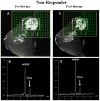In vivo 1H MRS in the assessment of the therapeutic response of breast cancer patients
- PMID: 21793075
- PMCID: PMC4226268
- DOI: 10.1002/nbm.1654
In vivo 1H MRS in the assessment of the therapeutic response of breast cancer patients
Abstract
MRI and in vivo MRS have rapidly evolved as sensitive tools for diagnosis and therapeutic monitoring in cancer research. In vivo MRS provides information on tumor metabolism, which is clinically valuable in the diagnosis and assessment of tumor response to therapy for the management of women with breast diseases. Several centers complement breast MRI studies with (1)H MRS to improve the specificity of diagnosis. Malignant breast tissues show elevated water-to-fat ratio and choline-containing compounds (total choline, tCho), and any effect of therapy on tissue viability or metabolism will be manifested as changes in these levels. Sequential (1)H MRS studies have shown significantly reduced tCho levels during the course of therapy in patients who were responders. However, there are challenges in using in vivo MRS because of the relatively low sensitivity in detecting the tCho resonance with decreased lesion size or significant reduction in the tumor volume during therapy. MRS is also technically challenging because of the low signal-to-noise ratio and heterogeneous distribution of fat and glandular tissues in the breast. MRS is best utilized for the diagnosis of focal masses, most commonly seen in patients with ductal-type neoplasms; however, it has limitations in detecting nonfocal masses, such as the linear pattern of tumors seen in invasive lobular carcinoma. Further work is required to assess the clinical utility of quantitative MRS, with the goal of automation, which will reduce the subjectivity currently inherent in both qualitative and semi-quantitative MRS.
Copyright © 2011 John Wiley & Sons, Ltd.
Figures






Similar articles
-
In vivo MRS of locally advanced breast cancer: characteristics related to negative or positive choline detection and early monitoring of treatment response.MAGMA. 2011 Dec;24(6):347-57. doi: 10.1007/s10334-011-0280-9. Epub 2011 Sep 10. MAGMA. 2011. PMID: 21909791
-
Improved diagnostic accuracy in differentiating malignant and benign lesions using single-voxel proton MRS of the breast at 3 T MRI.Clin Radiol. 2013 Sep;68(9):e502-10. doi: 10.1016/j.crad.2013.04.002. Epub 2013 May 23. Clin Radiol. 2013. PMID: 23706826
-
In vivo proton magnetic resonance spectroscopy of breast lesions: an update.Breast Cancer Res Treat. 2007 Sep;104(3):249-55. doi: 10.1007/s10549-006-9412-8. Epub 2006 Oct 19. Breast Cancer Res Treat. 2007. PMID: 17051424 Review.
-
In vivo proton magnetic resonance spectroscopy of breast cancer: a review of the literature.Breast Cancer Res. 2012 Apr 19;14(2):207. doi: 10.1186/bcr3132. Breast Cancer Res. 2012. PMID: 22515594 Free PMC article. Review.
-
Diagnostic value of breast proton magnetic resonance spectroscopy at 1.5T in different histopathological types.ScientificWorldJournal. 2012;2012:508295. doi: 10.1100/2012/508295. Epub 2012 May 1. ScientificWorldJournal. 2012. PMID: 22654620 Free PMC article.
Cited by
-
Breast Tissue Metabolism by Magnetic Resonance Spectroscopy.Metabolites. 2017 Jun 7;7(2):25. doi: 10.3390/metabo7020025. Metabolites. 2017. PMID: 28590405 Free PMC article. Review.
-
PET/MRI in cancer patients: first experiences and vision from Copenhagen.MAGMA. 2013 Feb;26(1):37-47. doi: 10.1007/s10334-012-0357-0. Epub 2012 Dec 25. MAGMA. 2013. PMID: 23266511
-
Magnetic Resonance Imaging (MRI) and MR Spectroscopic Methods in Understanding Breast Cancer Biology and Metabolism.Metabolites. 2022 Mar 27;12(4):295. doi: 10.3390/metabo12040295. Metabolites. 2022. PMID: 35448482 Free PMC article. Review.
-
MRS-based Metabolomics in Cancer Research.Magn Reson Insights. 2014 Feb 13;7:1-14. doi: 10.4137/MRI.S13755. eCollection 2014. Magn Reson Insights. 2014. PMID: 25114549 Free PMC article. Review.
-
Can Multi-Parametric MR Based Approach Improve the Predictive Value of Pathological and Clinical Therapeutic Response in Breast Cancer Patients?Front Oncol. 2018 Aug 15;8:319. doi: 10.3389/fonc.2018.00319. eCollection 2018. Front Oncol. 2018. PMID: 30159254 Free PMC article.
References
-
- Garcia M, Jemal A, Ward EM, Center MM, Hao Y, Siegel RL, Thun MJ. Global Cancer Facts & Figures 2007. American Cancer Society; Atlanta, GA: 2007.
-
- NCRP (National Cancer Registry Program) An Incidence and Distribution of Cancer. Indian Council of Medical Research; New Delhi: 2001. Consolidated Report (1990–1996)
-
- Booser DJ, Hortobagayi GN. Treatment of locally advanced breast cancer. Semin Oncol. 1992;19:278–285. - PubMed
-
- Kuerer HM, Newman LA, Buzdar AU, Dhingra K, Hunt KK, Buchholz TA, Binkley SM, Strom EA, Ames FC, Ross MI, Feig BW, McNeese MD, Hortobagyi GN, Singletray SE. Pathologic tumor response in the breast following neoadjuvant chemotherapy predicts axillary lymph node status. Cancer J Sci Am. 1998;4:230–236. - PubMed
-
- Graces CA, Cance WG. Neoadjuvant chemotherapy of breast cancer. Am Surg. 2004;70:565–569. - PubMed
Publication types
MeSH terms
Substances
Grants and funding
LinkOut - more resources
Full Text Sources
Other Literature Sources
Medical

